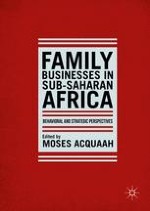2016 | OriginalPaper | Buchkapitel
7. The Direct and Indirect Effects of Innovative Capability on Firm Performance: Evidence from Micro and Small Family Businesses in Ghana
verfasst von : Ahmed Agyapong, Moses Acquaah
Erschienen in: Family Businesses in Sub-Saharan Africa
Verlag: Palgrave Macmillan US
Aktivieren Sie unsere intelligente Suche, um passende Fachinhalte oder Patente zu finden.
Wählen Sie Textabschnitte aus um mit Künstlicher Intelligenz passenden Patente zu finden. powered by
Markieren Sie Textabschnitte, um KI-gestützt weitere passende Inhalte zu finden. powered by
